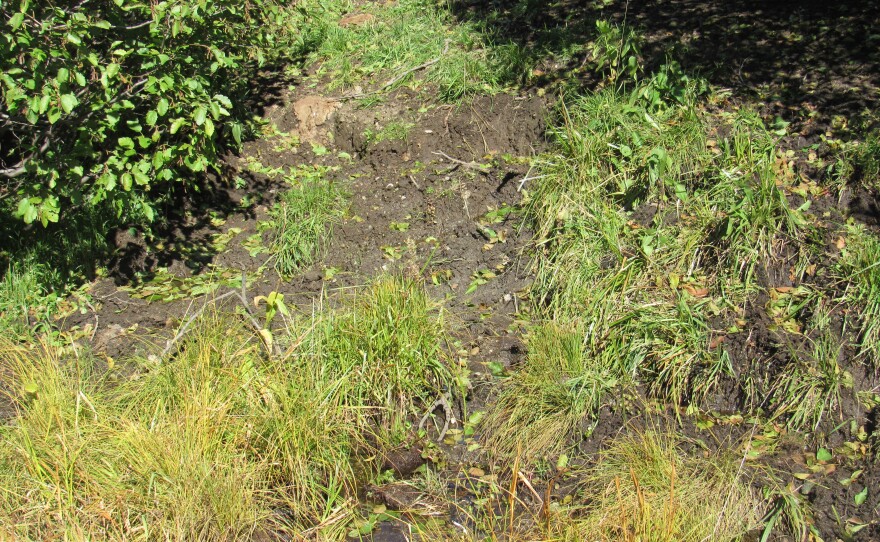The crest of the Siskiyou Mountains runs along the Oregon-California border, linking the Coast Range with the Cascades. Ranchers have grazed cattle on the crest for over a hundred years.
Now, environmentalists say the exceptional biodiversity of the high-altitude meadows is being damaged by overgrazing.
Luke Ruediger scans the ridgeline from the bottom of a huge bowl high in the Siskiyous …
“We’re standing in the Silver Fork Basin in the Silver Beaver grazing allotment in the Rogue River National Forest,” he says. “The Silver Basin has historically been one of the more heavily- grazed areas in the Rogue River side of the Siskiyou Crest.”
Ruediger is with the Klamath Forest Alliance, an environmental watchdog group based in Orleans, California. He and his colleague Felice Pace have hiked with me up to this high meadow about 20 miles southwest of Ashland. Ruediger notes there are two ranchers who have permits to graze their herds on this allotment.
“The cows from both of those permittees tend to congregate here in Silver Fork Basin and do a lot of damage to the stream banks, degrading water quality, and also perpetuating and compounding those historic impacts by continually grazing areas that have been heavily degraded.”
Felice Pace says cows prefer to hang around the wet parts of a meadow.
“Even though there’s a lot of forage available that’s outside of the wetlands, the grazing is still concentrated in there,” he says. “And it’s hard to maintain water quality when that kind of thing is happening where you’ve got the cattle hanging out in the wetlands.”
“You have a lot of fecal matter in the streams,” Ruediger adds. ”You also have a lot of bank trampling, which starts to impact the water table, which then has impacts downstream for fish and aquatic life.”
Pace points to patches of willow where the leaves have been eaten as high off the ground as cows can reach.
“They also push into the willow wetlands, and they fragment them. You can see the lines where they fragment that habitat.”
Pace says that ruins the habitat for birds such as the willow flycatcher, which nest near the ground.
We spend several hours hiking the floor of the basin, inspecting stream banks trampled into mud by hooves and dry, dusty areas denuded of grasses by heavy grazing. What’s needed, says Pace, is for these cattle to be more actively managed.
“What we have learned in eight years of monitoring 30 allotments on four or five different National Forests,” he says, “is there is very little presence of the Forest Service managers, there’s very little management by the permit holders. Basically, the cattle are released into the mountains and allowed to find where they want to graze and to stay there as long as they want to stay there.”
And that, he says, is a recipe for degradation of wetlands, grasslands and streams.
But Donna Mickley begs to differ. Mickley is the Siskiyou Mountain District Ranger for the Rogue River-Siskiyou National Forest. She says the grazing allotments are regularly monitored.
“So we go out, we get on the ground,” she says. “We have measurements, we have guidelines and that’s what we use to determine if we need to make changes in how the allotment is being managed.”
If it looks as though cows are over-using a certain area, Mickley says, her office will have the rancher relocate salt licks or take other actions to get the cattle to move.
“They can either move the salt or move the herd. They do have a large area, so we have the flexibility if we’re having an issue on one portion of the allotment to go take some riders out and make them shift those cows to a different part of the allotment.”
Mickley concedes there are isolated problem areas. But overall, she says, her staff is going a good job of protecting the resource. A few years ago, she says, a team of specialists collected data along the Siskiyou Crest.
“And it looked really good,” she says. “The results that we got back were really good. We have these areas that we need to work on, but a lot of it is doing well.”
Managers on the south side of the Crest, at the Klamath National Forest, also feel they’ve got things under control. Like Mickley, they say they keep a close eye out for problems and use a variety of approaches to fix them when they arise.
They answered questions via email but declined to be interviewed because of a lawsuit. Several years ago, environmental groups – including the Klamath Forest Alliance – sued the Klamath National Forest, saying managers had failed to properly study the impacts of livestock grazing in the Siskiyous. The Ninth Circuit Court of Appeals agreed and ordered a new environmental assessment.
Klamath National Forest officials wouldn’t discuss the lawsuit, but Felice Pace says the court-ordered environmental analysis has yet to be done.
Luke Ruediger says one obstacle to improved grazing management is that the Forest Service is working off of outdated information. For example, he says, some of the grazing plans on the Rogue River side haven’t been updated in decades.
“We’re looking at a 50-year backlog of science, research and analysis,” he says. And so, they’ve got a of lot of work ahead of them to kind of bring this somewhat archaic grazing system into the modern era.”
Donna Mickley acknowledges that backlog, and she says her team is working on it. But the Rogue River-Siskiyou National Forest is recovering from three major fires last summer, and available staff resources are spread thin.
At this point, Mickley says, there’s no projected timeline for updating those grazing plans.
More Reading ...
The Grazing Reform Project is a collaboration of the Environmental Protection Information Center, the Klamath Forest Alliance and Wilderness Watch. The project has been monitoring grazing allotments for years in the Klamath, Shasta and Rogue River-Siskiyou National Forests. The reports are published here ...











